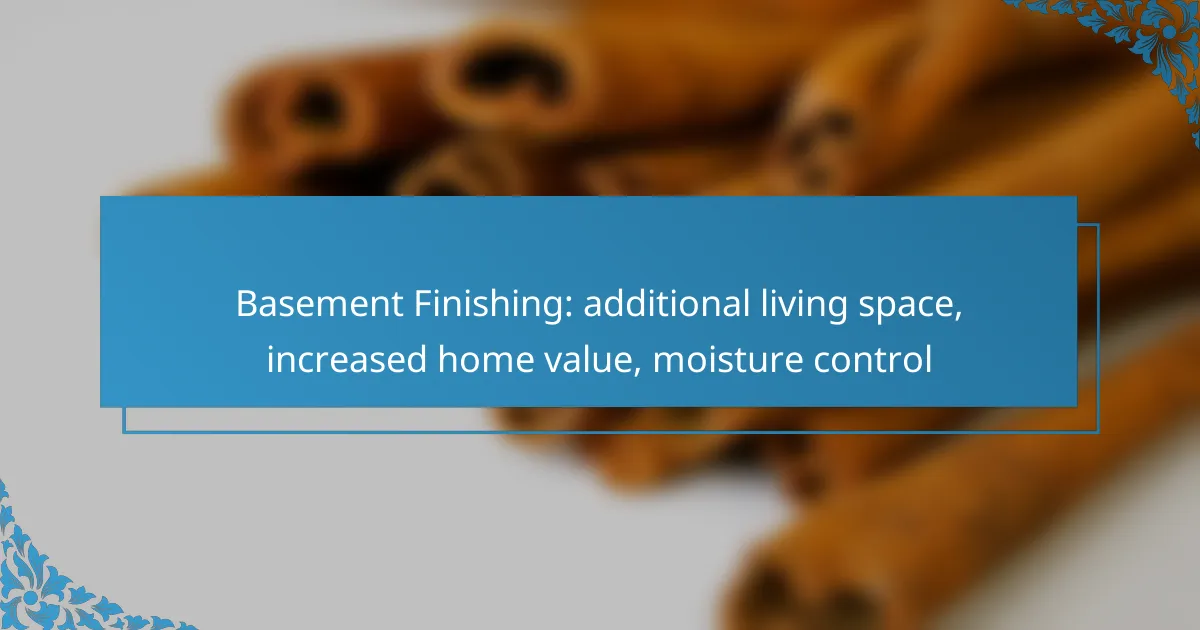Finishing a basement can transform an underutilized area into valuable living space, significantly increasing your home’s market appeal and value. Additionally, effective moisture control during this process is crucial for preventing damage and ensuring a healthy environment, safeguarding both the structure and air quality of your home.

How can basement finishing increase home value in Toronto?
Finishing a basement can significantly enhance home value in Toronto by transforming underutilized space into functional living areas. This improvement not only attracts potential buyers but also increases the overall market appeal of the property.
Enhanced property appeal
A well-finished basement can elevate the aesthetic and functional appeal of a home. Features like modern lighting, quality flooring, and stylish finishes can make the space inviting and versatile, appealing to a broader range of buyers.
In Toronto’s competitive real estate market, a finished basement can differentiate your property from others, making it more attractive to prospective buyers who are looking for move-in-ready homes.
Increased square footage
Finishing a basement effectively adds usable square footage to your home, which can be a key selling point. In Toronto, where space is often at a premium, this additional area can be marketed as extra living space for families or guests.
Typically, a finished basement can add anywhere from 30% to 50% more usable space, depending on the layout and design. This increase in square footage can justify a higher asking price when selling your home.
Potential for rental income
A finished basement can serve as a separate rental unit, providing a steady income stream. In Toronto, where rental demand is high, converting a basement into an apartment can yield significant monthly returns, often covering mortgage payments or other expenses.
When considering this option, ensure compliance with local regulations regarding rental units, including zoning laws and safety standards. A well-designed rental space can enhance both your property value and financial stability.

What are the benefits of moisture control in basement finishing?
Moisture control in basement finishing is essential for preventing damage and maintaining a healthy living environment. Effective moisture management reduces the risk of mold, improves air quality, and protects the structural integrity of the home.
Prevention of mold growth
Controlling moisture levels in a basement is crucial for preventing mold growth, which thrives in damp conditions. By using vapor barriers, proper drainage systems, and dehumidifiers, homeowners can significantly reduce humidity levels and inhibit mold spores from settling.
Regular inspections for leaks and ensuring proper ventilation can further enhance mold prevention efforts. It’s advisable to maintain indoor humidity below 60% to minimize mold risks.
Improved air quality
Moisture control directly contributes to improved air quality in finished basements. High humidity can lead to the proliferation of allergens and irritants, which can affect respiratory health.
Implementing air filtration systems and ensuring adequate ventilation can help circulate fresh air and reduce pollutants. This is particularly important in areas with high humidity, where stagnant air can exacerbate health issues.
Protection of structural integrity
Moisture can compromise the structural integrity of a basement by causing wood rot, rusting metal components, and weakening concrete. Proper moisture control measures, such as sealing cracks and installing sump pumps, can protect against water intrusion and damage.
Homeowners should regularly check for signs of water damage and address any issues promptly to maintain the basement’s structural soundness. Investing in moisture control solutions can save significant repair costs in the long run.

What are the key steps in the basement finishing process?
The basement finishing process involves several key steps that transform an unfinished basement into a functional living space. These steps include planning and design, obtaining necessary permits, framing and insulation, installing electrical and plumbing systems, and adding finishing touches.
Planning and design
Effective planning and design are crucial for a successful basement finishing project. Start by determining the purpose of the space, whether it will serve as a family room, home office, or guest suite. Create a layout that maximizes the available square footage while ensuring compliance with local building codes.
Consider factors such as natural light, ventilation, and access to utilities. Sketching a floor plan can help visualize the final outcome and identify any potential challenges early in the process.
Permitting and inspections
Before beginning construction, check with your local building authority to understand the permitting requirements for finishing a basement. Most areas require permits for structural changes, electrical work, and plumbing installations.
After obtaining the necessary permits, schedule inspections at key stages of the project to ensure compliance with safety standards and regulations. This can prevent costly modifications later on.
Framing and insulation
Framing is the next step, where you create the walls and define the layout of the space. Use moisture-resistant materials, especially in areas prone to dampness. Insulation is equally important to regulate temperature and improve energy efficiency.
Consider using foam board or spray foam insulation, which can provide better moisture control compared to traditional fiberglass batts. Ensure that all framing and insulation meet local building codes for safety and efficiency.
Electrical and plumbing installation
Once the framing and insulation are in place, proceed with electrical and plumbing installations. Hire licensed professionals to ensure that all work is up to code and safe. Plan the layout for outlets, lighting fixtures, and any plumbing fixtures you intend to install.
Be mindful of the placement of electrical panels and water lines, as these can affect the overall design and functionality of the finished basement.
Finishing touches
The final stage involves adding the finishing touches that will make the space comfortable and aesthetically pleasing. This includes drywall installation, painting, flooring, and installing fixtures such as cabinets and lighting.
Choose materials that are durable and suitable for basement environments, such as moisture-resistant paint and flooring options like vinyl or tile. Personalize the space with decor that reflects your style while ensuring it remains functional and inviting.

What factors should you consider when hiring a contractor in Ontario?
When hiring a contractor in Ontario for your basement finishing project, consider their experience, licensing, and client feedback. These factors will help ensure you choose a qualified professional who can effectively manage your project and meet local regulations.
Experience and expertise
Look for contractors with a solid track record in basement finishing. Experienced professionals are more likely to understand the nuances of local building codes and can provide creative solutions to common challenges.
Ask potential contractors about their previous projects, specifically those similar to yours. A portfolio showcasing their work can give you insight into their style and capabilities.
Licensing and insurance
Ensure that the contractor holds the necessary licenses to operate in Ontario. This is crucial for compliance with local regulations and building codes.
Verify that they have liability insurance and workers’ compensation coverage. This protects you from potential liabilities arising from accidents or damages during the project.
Client reviews and references
Check online reviews and ask for references from past clients. Positive feedback can indicate a contractor’s reliability and quality of work.
Contact references directly to inquire about their experiences. Ask specific questions about the contractor’s communication, adherence to timelines, and overall satisfaction with the finished project.

How does basement finishing compare to other home renovations?
Basement finishing is often more cost-effective than many other home renovations, providing additional living space and increasing home value. It typically requires less investment compared to major remodels like kitchen or bathroom renovations, while offering a significant return on investment.
Cost-effectiveness
Finishing a basement can range from a few thousand to tens of thousands of dollars, depending on the scope of the project. On average, homeowners can expect to spend between $20,000 and $50,000, which is generally lower than the costs associated with kitchen or bathroom remodels.
In terms of return on investment, finished basements can yield returns of around 70% to 75% when selling a home. This makes it a smart financial choice for homeowners looking to enhance their property value without overspending.
To maximize cost-effectiveness, consider prioritizing essential features like insulation and moisture control, which can prevent future expenses related to water damage. Always obtain multiple quotes from contractors to ensure competitive pricing and quality work.
